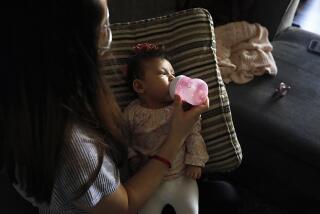Among the Poor, Number of Bottle-Fed Babies on the Rise
- Share via
While industry surveys show that overall formula sales are steady in the United States, there is concern about one large group of babies that has experienced a significant rise in formula use over the past decade, despite the benefits of breast-feeding. They are the babies from poor and near-poor families covered by the federal Women, Infant and Children supplemental food program, and they now make up almost half of all American infants.
Industry sources estimate that as much as 60% of all formula is purchased today through WIC, double the level of a decade ago. The program has expanded quickly in recent years as federally mandated competitive bidding for infant formula has pushed prices down to a small fraction of wholesale price. The result: Free formula has been made available to millions of mothers and their babies.
Yet official federal policy, including WIC policy, is to promote breast-feeding as the best way to feed an infant. In an effort to address the apparent contradiction in its policies, WIC has been hiring breast-feeding specialists to encourage and help WIC mothers and now provides an upgraded package of foods for breast-feeding women. Officials believe breast-feeding rates in WIC have increased recently as a result, but acknowledge they remain low.
“People tend to think of us as a place that dispenses formula,” said Pat Garrett, a WIC breast-feeding specialist in the Falls Church, Va., office. “It’s a misunderstanding, but it’s widespread.”
Garrett says that not enough WIC mothers receive good information about the mechanics and benefits of breast-feeding in the hospital. As a result, they are easily attracted to formula, which most are given as going-home gifts. She said many WIC mothers come from homes where breast-feeding is not supported and where formula is seen as the surest way to keep the baby healthy and sleeping through the night.
Statistics about breast-feeding by WIC mothers are sketchy. A 1997 study by the Department of Agriculture found that 31% of WIC mothers initiated breast-feeding, but that only 16% were still nursing after five months. Another study sponsored by the Department of Health and Human Services and published this year found that 40% of mothers at a WIC clinic in Baltimore started breast-feeding, but that only 20% were still nursing after 10 days. In the general population, 58% of women start breast-feeding, but only about 30% are still nursing when the baby is 3 months.
“The whole bottle-feeding culture is so pervasive,” said Kiran Saluja, head of the breast-feeding promotion committee of the National Assn. of WIC Directors. “It’s easy and it’s available--you can see how much your baby has gotten and it seems like you don’t have as many worries.”
“The benefits of breast-feeding take a longer time to see,” she said. “So I think we have to talk more about the health problems that can come along with formula for mother and the baby. And we need to make workplaces and neighborhoods friendlier for breast-feeding women.”
While WIC officials do want more mothers to breast-feed, they believe much of the WIC formula is serving a worthy purpose. “Many poor women using formula now might otherwise be using cow’s milk, which is much worse,” Saluja said. Cow’s milk, she said, lacks many of the nutrients that infants need to thrive.






